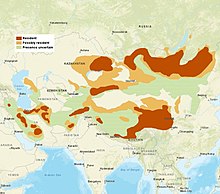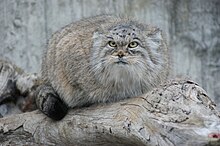Manul
| Manul | ||||||||||||
|---|---|---|---|---|---|---|---|---|---|---|---|---|

Manul ( Otocolobus manul ) |
||||||||||||
| Systematics | ||||||||||||
|
||||||||||||
| Scientific name of the genus | ||||||||||||
| Otocolobus | ||||||||||||
| Brandt , 1841 | ||||||||||||
| Scientific name of the species | ||||||||||||
| Otocolobus manul | ||||||||||||
| ( Pallas , 1776) |
The manul ( Otocolobus manul , Syn. : Felis manul ), also Pallas Cat (by Peter Simon Pallas ), is a small cat species from Central Asia .
features
A manul is about the size of a house cat , the head body length is 60 centimeters, and the tail is 25 to 31 centimeters long. Due to the stocky shape, the relatively short legs and the thick, long-haired fur, the Manul looks much larger than a house cat. The rounded ears are set quite low on the head and presumably represent an adaptation to the habitat with little cover for predators. In contrast to most other small cats, the pupils of the Manul are round.
The coat is yellow ocher and has some black horizontal stripes, which are not always easy to see in thick hair. There are small differences in coloration between the three subspecies. Compared to other wild cats, the fur is longer, on the belly even twice as long as on the back or on the sides. The tips of each hair are white. As with the snow leopard , the thick fur protects the animal from the cold and snowy winter that is typical of its habitat. The combination of a stocky figure and dense, downy fur also make the Manul appear larger than he actually is.
The weight varies between 2.0 and 4.5 kilograms.
habitat
Manul is widespread from Transcaucasia and northern Iran via Afghanistan , Kazakhstan , Uzbekistan , Turkmenistan , Tajikistan , Kyrgyzstan , northern Pakistan , Ladakh , Tibet and Xinjiang to southern Siberia and Mongolia. In the northeast he advances to Lake Baikal . It lives in rocky steppes, preferably in the mountains, where it occurs at heights of over 3,000 meters.
Way of life
Manule are nocturnal loners who sleep through the day in crevices and caves. Its prey animals are stone fowl , pipebirds , mice and chicks .
The gestation period is about 66 days. A litter has five to six young.
Systematics
Originally the Manul was assigned to the genus Felis . Since it is now clear that it is more closely related to the old cats ( Prionailurus ) than to the old world wild cats ( Felis ), it was placed as a single species in the genus Otocolobus .
| Cats |
|
||||||||||||
|
|
| Small cats |
|
||||||||||||||||||||||||||||||||||||||||||||||||||||||||||||
|
|
Relationships of cats according to O'Brien & Johnson 2008.
Existence and endangerment
The total population of the manul is estimated by the IUCN to be less than 50,000 adults . It is also assumed that stocks will continue to decline. The manul is classified as near threatened .
As with many wild cats worldwide, the greatest dangers lie in the increasing fragmentation of the habitat due to urbanization and the expansion of agriculture. In addition, the Pallas cats repeatedly fall victim to feral domestic dogs and the poison baits that are laid out against cattle robbers.
Hunting for their pelts has played a major role in Mongolia, China, and Russia, but international trade has largely ceased since the 1980s (Nowell and Jackson 1996). Hunting for private purposes is only tolerated in Mongolia. It is assumed that around 1000 households will remain, killing an average of two animals per year (Wingard and Zahler 2006). In addition, the manul is often accidentally shot because it is easily mistaken for the native marmots that are hunted in large numbers.
literature
- Kristin Nowell, Peter Jackson: Status Survey and Conservation Action Plan. Wild cats. IUCN - The World Conservation Union, 1996. ISBN 2-8317-0045-0 , pp. 97-98. (PDF download; 23.4 MB)
- John Seidensticker, Susan Lumpkin: Big Cats. Jahr-Verlag, Hamburg, ISBN 0-86438-233-2 , p. 50.
- DE Wilson, DM Reeder: Mammal Species of the World. Johns Hopkins University Press, Baltimore 2005, ISBN 0-8018-8221-4 .
Individual evidence
- ↑ John Seidensticker, Susan Lumpkin: Big Cats. P. 50
- ^ Kristin Nowell, Peter Jackson: Status Survey and Conservation Action Plan. Wild cats. P. 98
- ^ Reginald Innes Pocock: Primates and Carnivora. 2nd Edition. Taylor and Francis, London 1939 ( The Fauna of British India, Mammalia. Volume 1).
- ↑ Arkadi Aleksandrovich Sludskiĭ, Vladimir Georgievich Geptner: Mlekopitayushchie Sovetskogo Soyuza. Vȳsshaya Shkola, Moscow 1972.
- ↑ Volunteers collect important new information about rare and threatened Pallas cats. In: Biosphere Expeditions. February 26, 2013, accessed February 27, 2013 .
- ↑ WE Johnson, Eizirik, E., Pecon-Slattery, J., Murphy, WJ, Antunes, A., Teeling, E. and O'Brien, SJ (2006): The Late Miocene radiation of Modern Felidae: A genetic assessment . Science January 2006: Vol. 311 no. 5757: pp. 73-77 ( abstract )
- ↑ Stephen J. O'Brien, Warren E. Johnson: The new family tree of cats , in spectrum of science , issue 6/08, spectrum of science publishing company mbH, Heidelberg, pp. 54-61
- ↑ Stephen J. O'Brien, Warren E. Johnson: The New Pedigree of Cats. Spectrum of Science, Edition 6/08, Spectrum of Science, Publishing Company Ltd, Heidelberg, pp. 54–61
- ↑ Otocolobus manul (Manul, Pallas's Cat). Retrieved July 31, 2018 .
Web links
- Species profile Manul; IUCN / SSC Cat Specialist Group in English
- Otocolobus manul in the endangered Red List species the IUCN 2008 Posted by: S. Ross &. a., 2008. Retrieved January 6, 2009.


